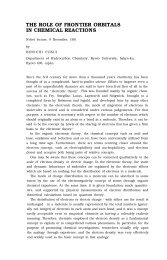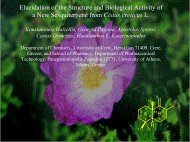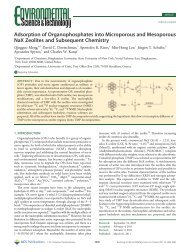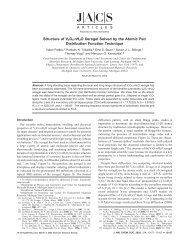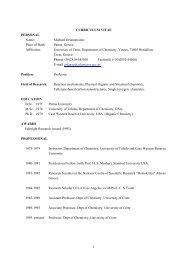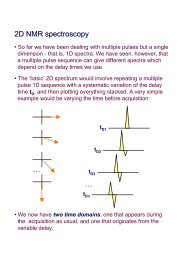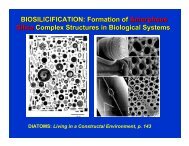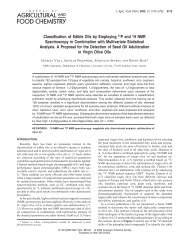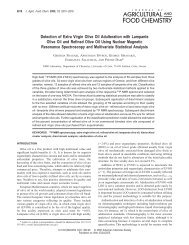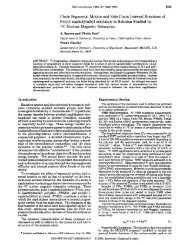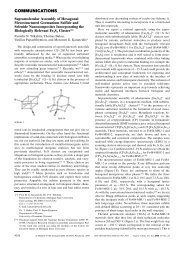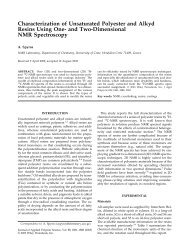Lecture-4 (general principles of biomineralization)
Lecture-4 (general principles of biomineralization)
Lecture-4 (general principles of biomineralization)
You also want an ePaper? Increase the reach of your titles
YUMPU automatically turns print PDFs into web optimized ePapers that Google loves.
General Principles <strong>of</strong> Biomineralization‣ Information is available about the structures <strong>of</strong>biominerals‣ How they vary in different organisms‣ Little is known about the detailed molecularinteractions governing their construction‣ However, there are some “<strong>general</strong> <strong>principles</strong>”
Biologically induced <strong>biomineralization</strong>‣ OH - fluxes are involved with precipitation <strong>of</strong> oxides,carbonates and phosphates‣ H 2 S and electrons induce precipitation <strong>of</strong> sulfides andmixed-valence iron oxides‣ Some bacteria are able to accumulate and passivatetoxic metal ions, such as UO 22+, Pb 2+ , Cd 2+‣ Biologically induced <strong>biomineralization</strong> could have animportant role in clean up <strong>of</strong> polluted waters andsoils
Biologically induced <strong>biomineralization</strong>
Biologically induced <strong>biomineralization</strong>Epicellular <strong>biomineralization</strong>
Epicellular <strong>biomineralization</strong>‣ Minerals form along the surface <strong>of</strong> the cell‣ They remain firmly attached to the cell wall‣ In some cases individual cells become totally encrustedin the mineral deposit. They increase in weight andsink to the bottom <strong>of</strong> the ocean forming sediments‣ Organic components (lipids, proteins, polysaccharides)<strong>of</strong> the cell wall are involved, by creating surfaces forprecipitation
Control and Morphology inEpicellular <strong>biomineralization</strong>‣ There is no strict cellular control‣ Size, shape, structure, composition and organization arepoorly defined and heterogenous20 nmIrregularly shaped Fe 3 O 4(magnetite) particlesProduced by a bacteriumCalled GS-15
Biologically Controlled <strong>biomineralization</strong>‣ Biologically controlled <strong>biomineralization</strong> is a highlyregulated process‣ It produces minerals such as bones, shells, and teeththat have specific biological functions and structures‣ These biominerals are identified by their species-specificcrystallochemical properties
Characteristics <strong>of</strong> these biominerals
Example: Magnetotactic Bacteria
Site-directed<strong>biomineralization</strong>: : it occursAt specific sites‣ Epicellular(on the cell wall)‣ Intercellular(in the spaces between closely packed cells)‣ Intracellular(inside enclosed compartments within the cell)‣ Extracellular(on or within an insoluble macromolecularframework outside the cell)
Lipid VesiclesMineralization in small spaces
Macromolecular frameworks‣ Vesicles are not suitable for building large structuressuch as bones, shells or teeth‣ An organic matrix is needed‣ It is composed <strong>of</strong> insoluble proteins andpolysaccharides such as collagen or chitin‣ The mineral phase is deposited in close associationwith the organic matrixEarly stages <strong>of</strong> egshellFormation showing calciteCrystals and macromolecularfibers
Site RequirementsAlthough the mechanisms that govern the biological control <strong>of</strong>Biomineralization vary enormously in different systems, there areFour basic requirements associated with mineralization sites, suchAs vesicles and macromolecuar frameworks‣ Spatial delineationFor size and shape control‣ Diffusion-limited ion flowFor controlling solution composition‣ Chemical regulationfor increasing ionic concentrations‣ Organic surfacesFor controlling nucleation
Control mechanisms: regulation <strong>of</strong> chemistry,space, structure, morphology, and construction
Chemical controlFour fundamental physicochemical factors‣ Solubility‣ Supersaturation‣ Nucleation‣ Crystal growthThese are chemically controlled in <strong>biomineralization</strong> bycoordinated ion transport and molecular-based inhibitorsand promoters
Spatial controlThe control <strong>of</strong> space in <strong>biomineralization</strong> occurs throughthe supramolecular pre-organization <strong>of</strong> organicmolecules, and impacts on the size and shape <strong>of</strong>mineral deposits and the chemical mechanisms <strong>of</strong> theirdeposition
Structural controlNon-oriented mosaic Iso-orientedThe organic matrix acts as an organic templatefor inorganic nucleationInterfacial molecular recognition
Morphological control
‣ Vectorial regulationMorphological control‣ Mineral growth process is controlled by organicboundaries that change in size and shape withtime‣ The inorganic phase is progressively routed alongspecific directions set by a biological program‣ Patterning program… morphogenesis
Constructional control‣ Controlled construction <strong>of</strong> hierarchical structures‣ Assembly <strong>of</strong> mineral-based building blocks into aseries <strong>of</strong> progressively higher-order structures‣ In bone, tiny crystals <strong>of</strong> hydroxyapatite are interwovenwith collagen fibers‣ Biomineral tectonics
General model




